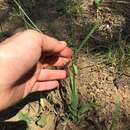en
names in breadcrumbs


Freesia laxa, commonly known as flowering grass,[2] is a small species of cormous flowering plant in the family Iridaceae, from eastern and southern Africa, from Kenya to northeastern South Africa.[1] It is grown in gardens as an ornamental plant.
Freesia laxa grows from corms, reaching about 15–30 cm (6–12 in) tall. The green leaves are arranged in a flat "fan" from which the flower stalk emerges. The flowers are flattened, about 2 cm (0.8 in) across. Their colour varies considerably. The ground colour is red, white or pale blue. The bases of the lowest three tepals usually have a darker marking, which may be red or purple, although it is absent in the pure white form. The seeds are bright red.[3][4]
It is native to the eastern side of southern Africa,[3] from Kenya to South Africa,[1] where it grows in somewhat moist conditions. It dies down to a corm in the winter, growing again at the end of spring and flowering in summer.[3] In the wild, in the Southern Hemisphere, it flowers between October and December.[4]
This small bulbous species has been known by a variety of names. The name Gladiolus laxus was originally published by Carl Thunberg in 1823. Peter Goldblatt transferred the species to Anomatheca laxa in 1971; Nicholas Brown changed it to Lapeirousia laxa in 1928; Goldblatt with his colleague John Charles Manning settled on Freesia laxa in 1995.[1] Separately, in 1830, John Lindley described Anomatheca cruenta which John Baker transferred to Lapeirousia cruenta in 1892.[5] Lindley's plant is now regarded as part of Freesia laxa.[1]
Forms with blue flowers are treated as Freesia laxa subsp. azurea, other forms being placed in Freesia laxa subsp. laxa.[6]
Freesia laxa is sufficiently hardy to be grown outdoors in all but the coldest parts of the British Isles.[3] It requires a light soil and a sunny position. In colder areas, the corms can be lifted and dried off during the winter. It can be propagated by dividing groups of corms or by seed.[3] It can be somewhat invasive through self-sowing when grown in favourable conditions.[6]
This plant[2] and the white-flowered cultivar F. laxa var. alba[7] have gained the Royal Horticultural Society's Award of Garden Merit.[8]
Freesia laxa, commonly known as flowering grass, is a small species of cormous flowering plant in the family Iridaceae, from eastern and southern Africa, from Kenya to northeastern South Africa. It is grown in gardens as an ornamental plant.